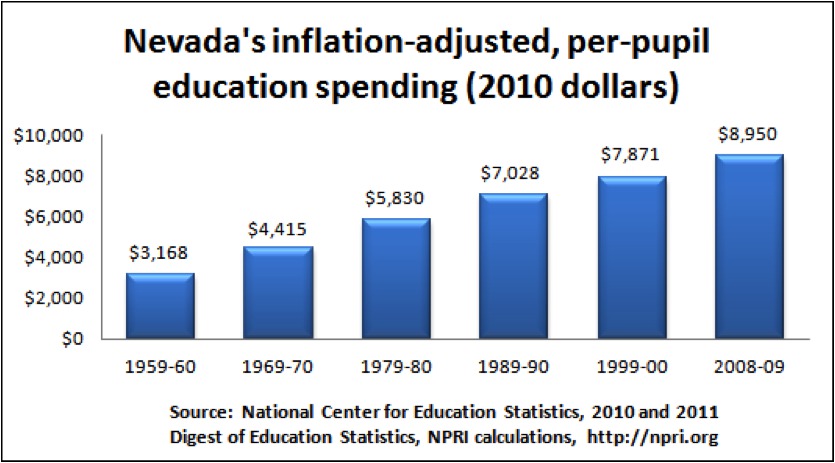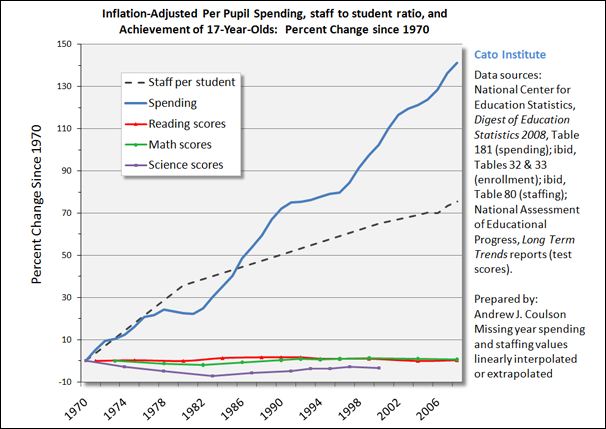Analysis shows little to no correlation between education spending and student achievement
After 50 years of spending more, union bosses still want a blank check
- Thursday, May 17, 2012
Union bosses and other liberals have long argued that Nevada must spend more on K-12 education in order to increase student achievement.
And in one sense, at least, they have been incredibly successful: Nevada has nearly tripled inflation-adjusted, per-pupil spending in the last 50 years.

Student achievement, however, has stagnated, with Nevada's graduation rate — as reported by Education Week — plummeting to 44.3 percent.
Spending more, even spending a lot more, has not produced the gains in student learning that liberals promised.
Despite the refrain being disproven, union bosses continue to parrot it. On its website, the Clark County Education Association writes, "Funding for education has been shortchanged [sic] by Nevada's legislators for too long. Their lack of leadership and courage to adequately fund public education has resulted in our state ranking dead-last in the nation in investment in education, resulting in the hampering of innovation and excellence."
The CCEA's state-level affiliate, the Nevada State Education Association, is preparing for direct action. The Las Vegas Sun reports that the NSEA is preparing to file a business margins-tax initiative to increase education funding by $1 billion.
Unfortunately for the cause of genuine educational progress — and for Nevada's parents and students — this union-boss effort would only further entrench the failing status quo. The reason is that little to no correlation exists between spending and student achievement.
Nevada isn't the only state to have dramatically increased education spending in previous decades with little to no increase in student achievement to show for it. Nationwide, inflation-adjusted, per-pupil education spending has increased by about 140 percent in the last 40 years, and the number of teachers per pupil has increased by over 70 percent.
Student achievement, however, has been hovering around the same level — or even decreasing — for decades.

The following state-by-state analysis shows that there is no statistically significant correlation between spending and student achievement. This is seen when Fiscal Year 2009 spending on current expenditures is compared with reading and math scores on the 2009 National Assessment of Educational Progress (NAEP).
These simple regression-analysis charts report the correlation of state education spending with student performance on the NAEP fourth-grade reading and math tests. Assuming a 95 percent confidence level, they yield R2 values of 0.03172 and .01822, respectively. Also called the coefficient of determination, R2 is one of the best means for evaluating the strength of a relationship.
In these cases, the correlation between spending and student achievement is, at best, only 3.18 percent and 1.82 percent, respectively. This extremely weak relationship is graphically demonstrated by the fact that the data points are not closely grouped along the regression trend line, but are literally all over the charts.
Some commentators, such as Agenda co-host Hugh Jackson, have claimed that because some top-spending states, like Connecticut, New Jersey and Vermont, boast high test scores, a correlation exists between spending and student achievement. Liberals like Jackson, however, ignore the top-spending locales that boast low test scores, such as Washington, D.C., Alaska and New York.
When little to no correlation exists between spending and student achievement, such scores are exactly what you'd expect. Some top-spending states score well; others score poorly. The converse is also true: Some low-spending states score well, while others score poorly.
Analysis of the relationship between FY 2008 total spending levels and scores on the 2009 eighth-grade NAEP reading and math tests reveals, once again, virtually no correlation between spending and student achievement. (This data was featured in Solutions 2013, and was the most current data available when that sourcebook for policymakers was written. The NAEP was not given in 2008.)
In these cases, R2 equals 0.01608 and 0.00939, respectively, which means the correlation here between spending and student achievement is merely 1.61 percent and 0.94 percent.
These low values indicate that virtually no relationship exists between spending levels and student achievement — much less a causal relationship. Yet, union bosses and liberals, relying on the public ignorance they have helped foster, have falsely claimed for decades that a causal relationship exists between these variables.
The real tragedy of these falsehoods is not found in numbers or statistics, however. It is found in the face of a schoolchild who is stuck in a failing school, year after year. It is found in the broken-hearted parents who cannot afford to send their children to effective schools. It exists throughout dispirited American communities that, after 50 years of trying to increase student achievement by spending more, find themselves berated by union bosses for not spending enough.
The real tragedy is that union bosses are fighting tooth and nail to prevent the real education reforms that would help your child go to an effective and motivating school.
Fifty years of evidence in 50 states have demonstrated emphatically that spending more is not the path to increased student achievement.
The future of Nevada's students — our children- requires Nevada to reject the lies of union bosses and institute proven reforms.
Victor Joecks is communications director at the Nevada Policy Research Institute. For more visit http://npri.org. Geoffrey Lawrence, NPRI's deputy policy director, assisted with the regression analyses.
Update (May 18, 2012): Changed "statistical" to "statistically significant."





